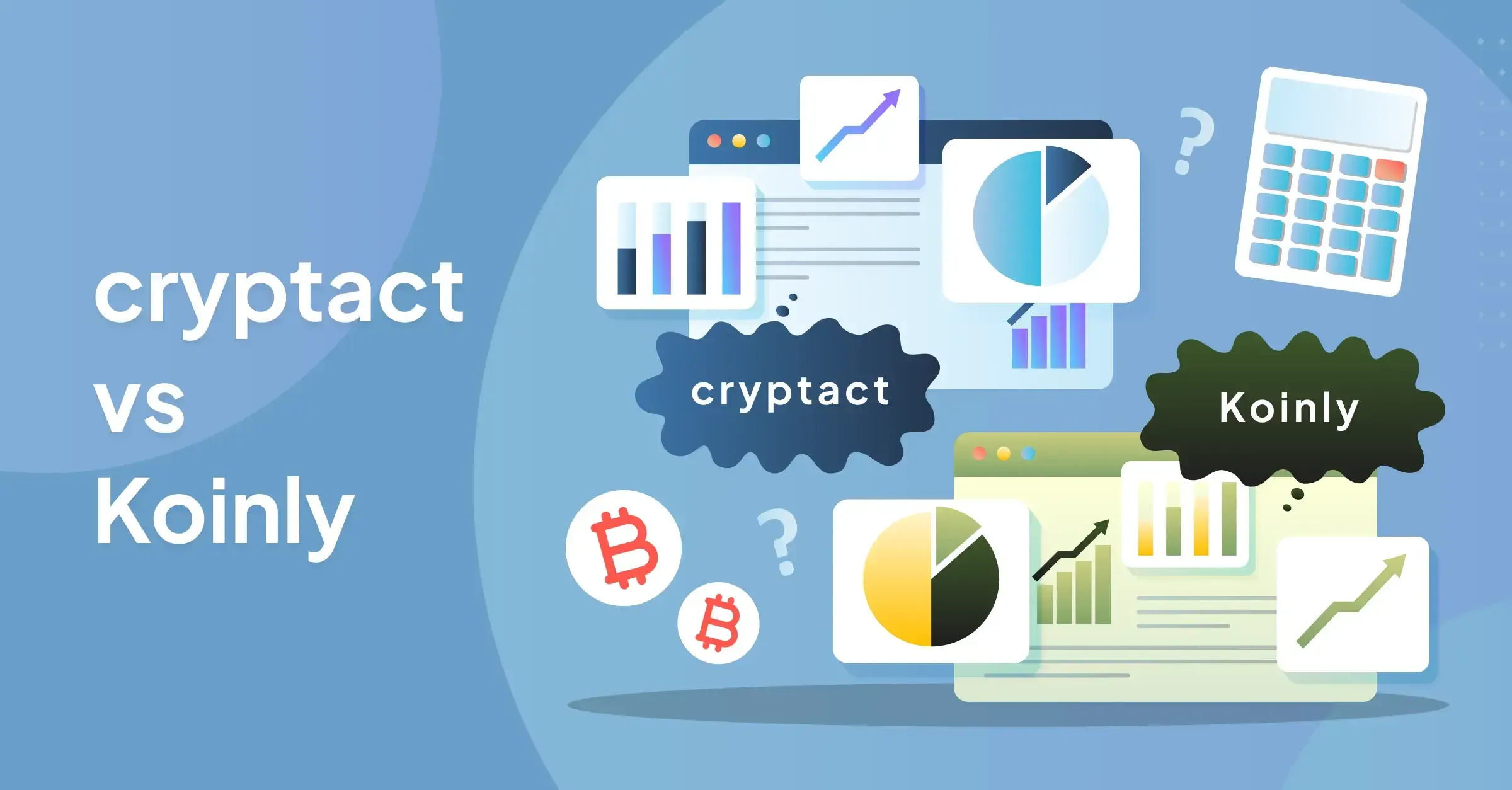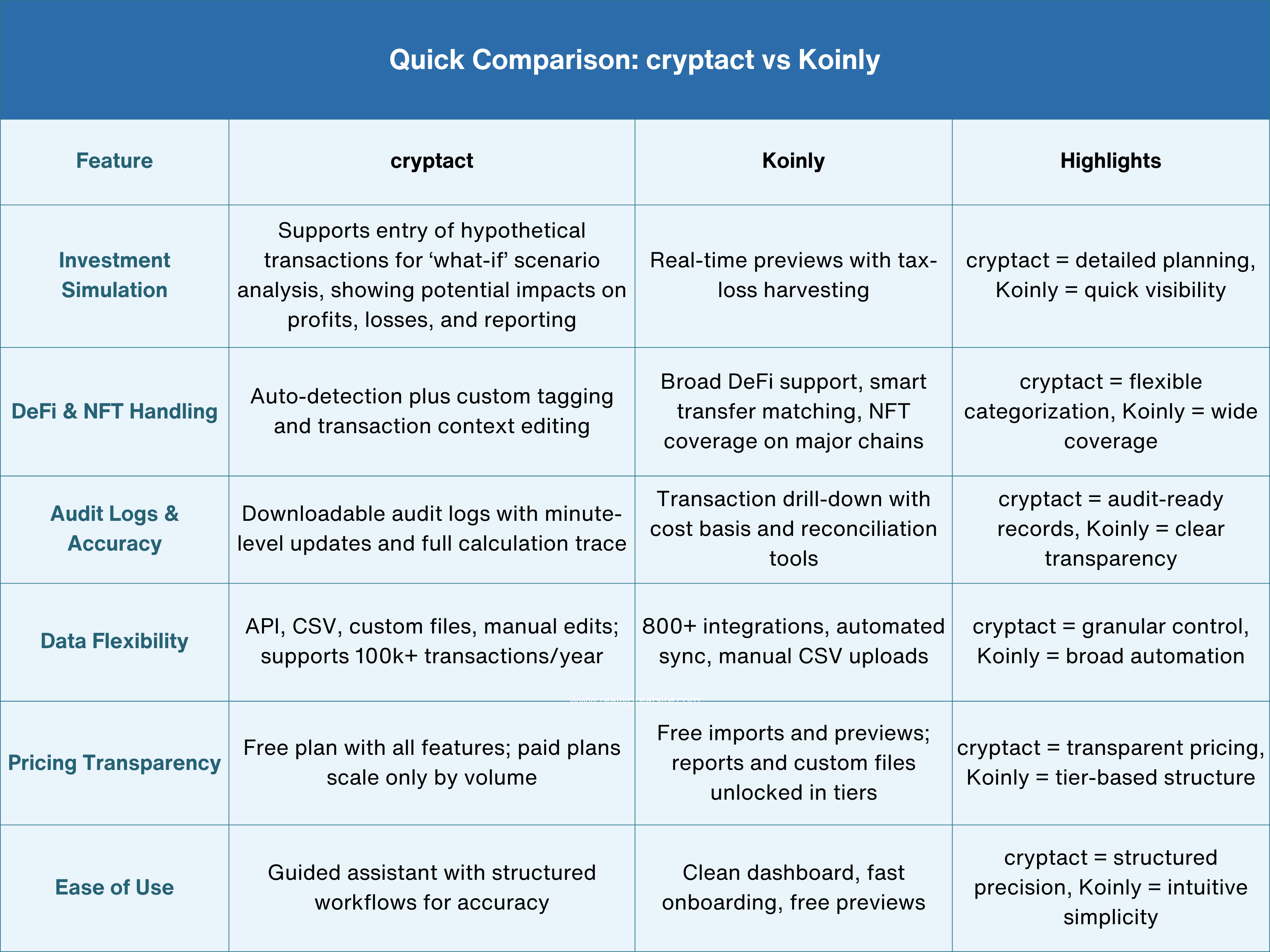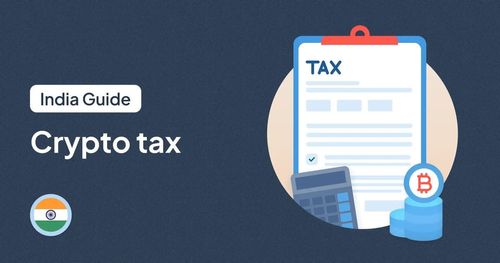
Filing crypto taxes is rarely straightforward. Most traders juggle transactions across multiple wallets, exchanges, and blockchains. Factor in DeFi, NFTs, and evolving tax rules, and the process quickly becomes complicated. Manual spreadsheets often lead to mistakes and wasted time.
Crypto tax software simplifies this challenge. Platforms like cryptact and Koinly automate profit and loss calculations, track portfolios, and generate ready-to-file tax reports. They aim to reduce stress, increase accuracy, help in staying tax-compliant, and save hours of manual effort.
Still, these two platforms are not identical. Each has its own approach, unique features, and specific advantages. In this guide, we’ll compare cryptact and Koinly side by side. Read on to find out more.
Table of contents |
No credit card required
About cryptact and Koinly
cryptact and Koinly pull data directly from wallets and exchanges, then turn it into clear profit, loss, and income summaries. What would normally take days in spreadsheets is done automatically in minutes.
Both platforms offer the basics you’d expect from any crypto tax tool: hundreds of wallet and exchange integrations, automated profit and loss calculations, and your tax reports. They also provide portfolio tracking and support for multiple transaction types.
The difference lies in how they fit your trading style and reporting needs.
So, let’s break down their features.
cryptact vs Koinly: Feature-by-Feature Comparison
Both cryptact and Koinly are among the best crypto tax software 2025. Below, we break down their strengths across key features so you can see where each tool stands out.
First, let’s have a quick comparison:

Now, let’s compare cryptact and Koinly in detail.
1. Tax Simulation Engine
cryptact includes an investment simulator function that lets you manually enter hypothetical transactions or disposal dates to run “what-if” scenarios. It helps you see how different choices could affect profits, losses, and reporting before you actually make a move. It’s a capability that sets cryptact apart in lists of the best crypto tax software 2025.
Koinly offers tax-loss harvesting and real-time previews of gains and losses. You can check the impact of disposals before finalizing trades. While it does not exactly simulate future trades, it gives strong year-round visibility into tax position.
2. DeFi and NFT Handling
cryptact auto-detects DeFi and NFT activity from wallet addresses.For complex entries, you can convert a DeFi import into an editable transaction and then edit or exclude it to avoid double‑counting.
Koinly also supports staking, liquidity, lending, and NFT trading with broad chain and wallet coverage and provides transfer matching to reduce misclassification. Coverage and depth can vary by chain and marketplace.
3. Audit Logs and Accuracy
Many traders ask, is cryptact more accurate than Koinly?
cryptact goes beyond surface-level labels. Instead of relying only on function names, it performs a deeper review of each transaction and smart contract—analyzing the source code, transaction inputs, and events. This ensures that complex DeFi activities are interpreted correctly and that profit and loss align with the actual movement of assets on-chain.
In addition, cryptact provides downloadable calculation results (transaction-level CSV) and tax report files, giving accountants audit-ready transparency.
Koinly also emphasizes clarity. Users can drill down into each transaction, check cost basis, and reconcile discrepancies. However, extremely complex DeFi cases may still require manual review to confirm accuracy.
4. Data Flexibility
cryptact supports APIs, CSV imports, and and gives users fine-grained control to adjust individual entries. You can click a trade in the transaction list to open its detail screen and edit fields (such as quantity, asset, price lookup on/off, or coin type).
For more extreme corrections, you can choose to exclude a transaction (removing it from profit/loss calculation while still keeping it visible) or delete it entirely (removing it from the history). Excluded trades can always be re-included later.
This flexibility is especially useful when reconciling complex histories—edge cases, nonstandard tokens, or imported data mismatches can be corrected directly at the transaction level
A common question is, does Koinly handle all blockchains? On a high level, Koinly supports over 800 exchanges, blockchains, and wallets. It automatically syncs with most major services and offers manual CSV uploads for unsupported platforms. Transaction limits depend on your plan and the tier you’re at.
5. Pricing Transparency
cryptact’s free plan includes all core features. These include live portfolio view, DeFi and NFT support, custom transactions, unlimited exchanges, and 25,000+ cryptocurrencies. Paid plans add higher limits, advanced reporting, and email support. Pricing is simple and volume-based, with no hidden tiers or forced upgrades.
Koinly lets you import unlimited wallets and transactions for free, with access to portfolio tracking, capital gains previews, and DeFi/NFT support. Tax reports, audit-ready exports, and custom file imports are available under paid plans. Pricing for paid plans scales with transaction volume. So, high-frequency traders may pay more in order to get access to all features, but costs are predictable and tier-based.
If you compare pricing of cryptact and Koinly, cryptact’s paid plans start at $45, while Koinly begins at $49 per tax year,
6. Ease of Use and Onboarding
cryptact includes an integrated assistant that guides users step by step. It reduces the learning curve, especially for those new to crypto tax filing.
Koinly has a clean, intuitive dashboard and allows free previews before purchase. The onboarding process is fast, with clear instructions for connecting wallets and exchanges.
cryptact vs Koinly: The Verdict
Traders often ask, do I need both cryptact and Koinly?The answer is no, one tool is enough. The real choice comes down to what matters most: speed, integrations, or long-term flexibility.
Getting started is simple with either tool. The difference is that cryptact lets you start quickly while also giving you audit-ready accuracy and scale, without locking features behind paid tiers.
In the cryptact vs Koinly debate, Koinly offers wide integrations and a straightforward setup. Cryptact matches that ease of use while also delivering accuracy, flexibility, and scale without locking features behind paid tiers. Even the free plan includes all core tools, and costs rise only with transaction volume.
As a strong Koinly alternative, cryptact appeals to both beginners and professionals who want reliable, audit-ready reporting.
With tax simulations, audit logs, and support for high transaction volumes, cryptact is built to grow with you. Try cryptact for free and see the difference.
Conclusion
The “cryptact vs Koinly” choice is less about beginner vs expert and more about workflow preference. If you value precise reconciliation and audit‑ready exports alongside a quick start, cryptact is designed to scale with you.
If you’re already on Koinly and wondering, can I import Koinly data to cryptact? The answer is yes. Check out our guide here.
In the end, for accuracy, flexibility, and fair pricing, cryptact is the stronger long-term choice. Learn more about cryptact by visiting the website.

